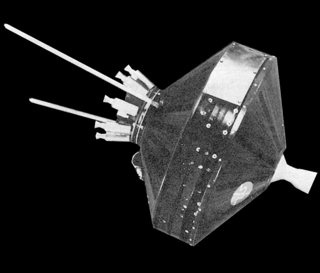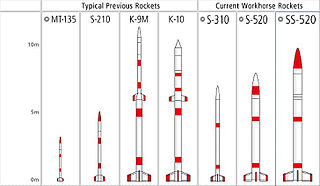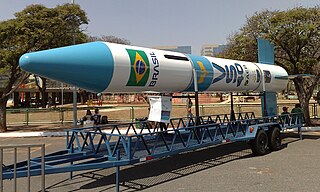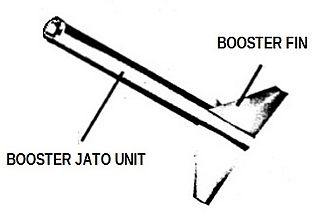Related Research Articles

A solid-propellant rocket or solid rocket is a rocket with a rocket engine that uses solid propellants (fuel/oxidizer). The earliest rockets were solid-fuel rockets powered by gunpowder; they were used in warfare by the Chinese, Persians, Mongols, and Indians as early as the 13th century.

Pioneer 1 was an American space probe, the first under the auspices of NASA, which was launched by a Thor-Able rocket on 11 October 1958. It was intended to orbit the Moon and make scientific measurements, but due to a guidance error failed to achieve lunar orbit and was ultimately destroyed upon reentering Earth's atmosphere. The flight, which lasted 43 hours and reached an apogee of 113,800 km, was the second and most successful of the three Thor-Able space probes.

The Black Brant is a family of Canadian-designed sounding rockets originally built by Bristol Aerospace, since absorbed by Magellan Aerospace in Winnipeg, Manitoba. Over 800 Black Brants of various versions have been launched since they were first produced in 1961, and the type remains one of the most popular sounding rockets. They have been repeatedly used by the Canadian Space Agency and NASA.

Titan IV was a family of heavy-lift space launch vehicles developed by Martin Marietta and operated by the United States Air Force from 1989 to 2005. Launches were conducted from Cape Canaveral Air Force Station, Florida and Vandenberg Air Force Base, California.

Atlas II was a member of the Atlas family of launch vehicles, which evolved from the successful Atlas missile program of the 1950s. It was designed to launch payloads into low earth orbit, geosynchronous transfer orbit or geosynchronous orbit. Sixty-three launches of the Atlas II, IIA and IIAS models were carried out between 1991 and 2004; all sixty-three launches were successes, making the Atlas II the most reliable launch system in history. The Atlas line was continued by the Atlas III, used between 2000 and 2005, and the Atlas V which is still in use.

The Lockheed X-7 was an American unmanned test bed of the 1950s for ramjet engines and missile guidance technology. It was the basis for the later Lockheed AQM-60 Kingfisher, a system used to test American air defenses against nuclear missile attack.

The Scout family of rockets were American launch vehicles designed to place small satellites into orbit around the Earth. The Scout multistage rocket was the first orbital launch vehicle to be entirely composed of solid fuel stages. It was also the only vehicle of that type until the successful launch of the Japanese Lambda 4S in 1970.

Loki, officially designated 76mm HEAA Rocket T220, was an American unguided anti-aircraft rocket based on the German Taifun. Like the Taifun, Loki never saw service in its original role, but later found widespread use as a sounding rocket. It was so successful in this role that several advanced versions were developed on the basic Loki layout, including the final Super Loki.

S-Series is a fleet of sounding rockets funded by the Japan Aerospace Exploration Agency (JAXA) that have been in service since the late 1960s. Manufactured by IHI Aerospace and operated by the Institute of Space and Astronautical Science (ISAS). The nomenclature of the S-Series rockets is the number of "S"s indicates the number of stages, and the following number details the diameter of the craft in millimeters. For example, the S-310 is a single stage rocket with a diameter of 310 mm.
Nike Hydac is the designation of an American sounding rocket with two stages, based upon the Nike Ajax booster. The Nike Hydac was launched 87 times from many missile sites. Such sites were White Sands Missile Range, Poker Flat Research Range, Kwajalein Missile Range, Cassino Site - Rio Grande Airport, Brazil, and from North Truro Air Force Station in Massachusetts during Operation Have Horn in 1969.
The Nike-Cajun was a two-stage sounding rocket built by combining a Nike base stage with a Cajun upper stage. The Nike-Cajun was known as a CAN for Cajun And Nike. The Cajun was developed from the Deacon rocket. It retained the external size, shape and configuration of the Deacon but had 36 percent greater impulse than the Deacon due to improved propellant. It was launched 714 times between 1956 and 1976 and was the most frequently used sounding rocket of the western world. The Nike Cajun had a launch weight of 698 kg (1538 lb), a payload of 23 kg (51 lb), a launch thrust of 246 kN (55,300 lbf) and a maximum altitude of 120 km (394,000 ft). It had a diameter of 42 cm and a length of 7.70 m. The maximum speed of the Nike-Cajun was 6,760 km/h (4,200 mph).

The VS-40 is a Brazilian sounding rocket using solid fuel, stabilized aerodynamically, distributed between the first stage S40TM (4,200 kg) engine and the second stage S44M (810 kg) engine. This configuration corresponds to the upper stages of the VLS-1 rocket.

The Terrier Malemute is a two-stage American sounding rocket typically used for smaller payloads. Both the Terrier first stage and the Malemute second stage use solid fuel. The Terrier burns for approximately 5.2 seconds, and the Malemute burns for approximately 21.5 seconds. The first stage booster consists of a surplus Navy Terrier MK 12 Mod 1 rocket motor with four 0.22 m2 (340 sq in) fin panels arranged in a cruciform configuration. The Terrier rocket booster has a diameter of 460 mm (18 in). The second stage solid rocket is a Thiokol Malemute TU-758 rocket motor, specially designed for high altitude research rocket applications. Apogee is approximately 400 km (220 nmi) for a 230 kg (510 lb) payload or 700 km (380 nmi) for a 41 kg (90 lb) payload. For a payload weight of 200 lb (91 kg), the acceleration during the boost phase is 26 g.
The Star is a family of US solid-propellant rocket motors originally developed by Thiokol and used by many space propulsion and launch vehicle stages. They are used almost exclusively as an upper stage, often as an apogee kick motor.

Capricornio was a Spanish satellite launch vehicle developed by the Instituto Nacional de Técnica Aeroespacial (INTA) in the 1990s. It was expected to be a low cost solution to place up to 70 kg payloads into 600 km polar orbits or 60 to 140 kg payloads into low Earth orbit. The Capricornio program was cancelled in 2000.

The Nike stage or Nike booster, a solid fuel rocket motor, was created by Hercules Aerospace for the Nike Ajax (M5) Nike Hercules (M5E1). It was developed for use as the first stage of the Nike Ajax and Nike Hercules missiles as part of Project Nike.

Vanguard SLV-2, also called Vanguard Satellite Launch Vehicle-2 hoped to be the second successful flight of the American Vanguard rocket following successful Vanguard 1 satellite on rocket Vanguard TV-4.

Vanguard SLV-3, also called Vanguard Satellite Launch Vehicle-3 hoped to be the second successful flight of the American Vanguard rocket following successful Vanguard 1 satellite on rocket Vanguard TV-4.

Vanguard SLV-6, also called Vanguard Satellite Launch Vehicle-Six, hoped to be the third successful flight of the American Vanguard rocket following the successful Vanguard 2 satellite on rocket Vanguard SLV-4. Vanguard Satellite Launch Vehicle-6 (SLV-6) was designed to carry a small spherical satellite into Earth orbit to study solar heating of Earth and the heat balance. A faulty second stage pressure valve caused a mission failure.
References
- ↑ http://www.alternatewars.com/BBOW/Space_Engines/Thiokol_ATK_Engines.html [ dead link ]
- 1 2 "Nike Yardbird". www.astronautix.com.